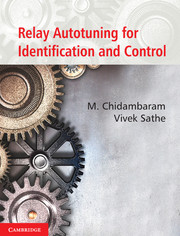Book contents
- Frontmatter
- Contents
- List of Figures
- List of Tables
- Acknowledgements
- Preface
- 1 Introduction
- 2 Improved Autotune Identification Methods
- 3 Cascade Controllers Tuning by Relay Autotune Method
- 4 Simultaneous Relay Autotuning of Cascade Controllers
- 5 A Simple Method of Tuning Cascade Controllers
- 6 Improved Saturation Relay Test for Systems with Large Dead Time
- 7 Identification of FOPTD Model using Single Symmetrical Relay Test
- 8 Autotuning of PID Controllers for Unstable FOPTD Systems
- 9 Autotuning of PID Controllers for Critically Damped SOPTD Systems
- 10 Estimation of SOPTD Transfer Function Model
- 11 Estimation of Five Parameters of Unstable SOPTD Model with a Zero
- 12 Identification of FOPTD Multivariable Systems
- 13 Identification of SOPTD Multivariable Systems
- 14 Tuning of Multivariable Controllers for Non-Minimum Phase Systems
- 15 Tuning of Multivariable Controllers by Genetic Algorithms
- 16 Summary and Conclusions
- Appendix A
- Appendix B
- Appendix C
- Nomenclature
- Problems
- Suggestive Reading
- References
- Index
1 - Introduction
Published online by Cambridge University Press: 05 June 2014
- Frontmatter
- Contents
- List of Figures
- List of Tables
- Acknowledgements
- Preface
- 1 Introduction
- 2 Improved Autotune Identification Methods
- 3 Cascade Controllers Tuning by Relay Autotune Method
- 4 Simultaneous Relay Autotuning of Cascade Controllers
- 5 A Simple Method of Tuning Cascade Controllers
- 6 Improved Saturation Relay Test for Systems with Large Dead Time
- 7 Identification of FOPTD Model using Single Symmetrical Relay Test
- 8 Autotuning of PID Controllers for Unstable FOPTD Systems
- 9 Autotuning of PID Controllers for Critically Damped SOPTD Systems
- 10 Estimation of SOPTD Transfer Function Model
- 11 Estimation of Five Parameters of Unstable SOPTD Model with a Zero
- 12 Identification of FOPTD Multivariable Systems
- 13 Identification of SOPTD Multivariable Systems
- 14 Tuning of Multivariable Controllers for Non-Minimum Phase Systems
- 15 Tuning of Multivariable Controllers by Genetic Algorithms
- 16 Summary and Conclusions
- Appendix A
- Appendix B
- Appendix C
- Nomenclature
- Problems
- Suggestive Reading
- References
- Index
Summary
Identification of transfer function models of a system is required for an improved tuning of controllers. Several methods have been reported in the literature for identification of transfer function models with two, three and four parameters (pure delay system, first order plus time delay (FOPTD), second order plus time delay (SOPTD), etc.) using relay feedback approach. In this section, the basics of conventional relay feedback method and modifications in the original autotuning method are reviewed for single-input single-output systems. Excellent reviews on relay tuning methods are given by Yu (1999, 2006), Hang et al. (2002) and Wang et al. (2003). Methods of designing PI/PID controllers based on the transfer function models are also briefly reviewed.
Relay Feedback Method
Åström and Hägglund (1984) suggested the use of an ideal (on–off) relay (Fig. 1.1) to generate a sustained oscillation in the closed loop. For positive gain process, on–off relay is defined by u = umax if e ≥ 0, and u = umin, if e < 0. For negative gain processes, on–off relay is defined by u = umin, if e ≥ 0, and u = umax if e < 0. Amplitude (a) and period of oscillation (pu) are noted from the sustained oscillation. This is a closed loop method for identification of transfer function models. The method is based on the observation that when an open loop output lags the input by π radians, the closed loop system may oscillate (Fig. 1.2) with a period Pu.
- Type
- Chapter
- Information
- Relay Autotuning for Identification and Control , pp. 1 - 11Publisher: Cambridge University PressPrint publication year: 2014



